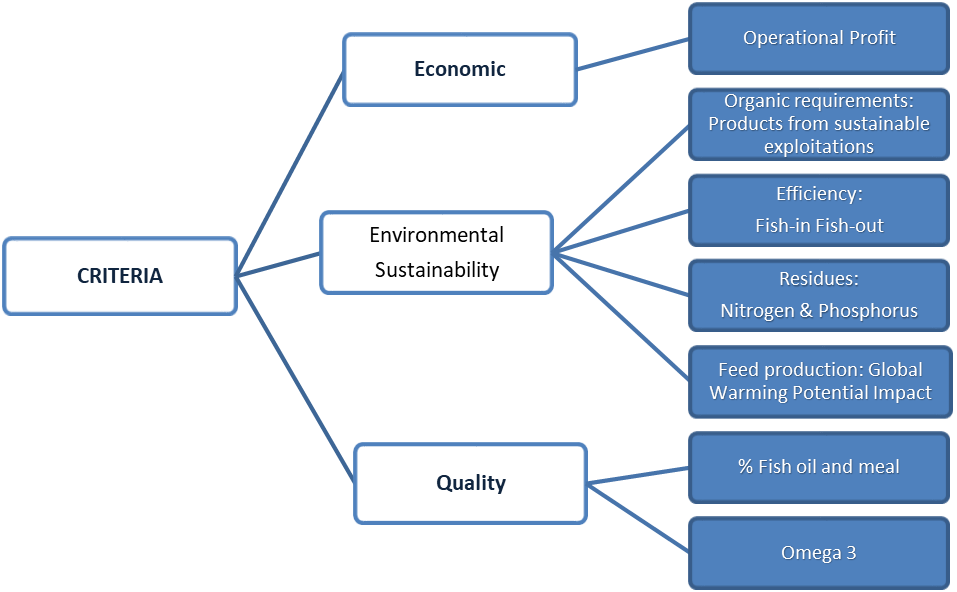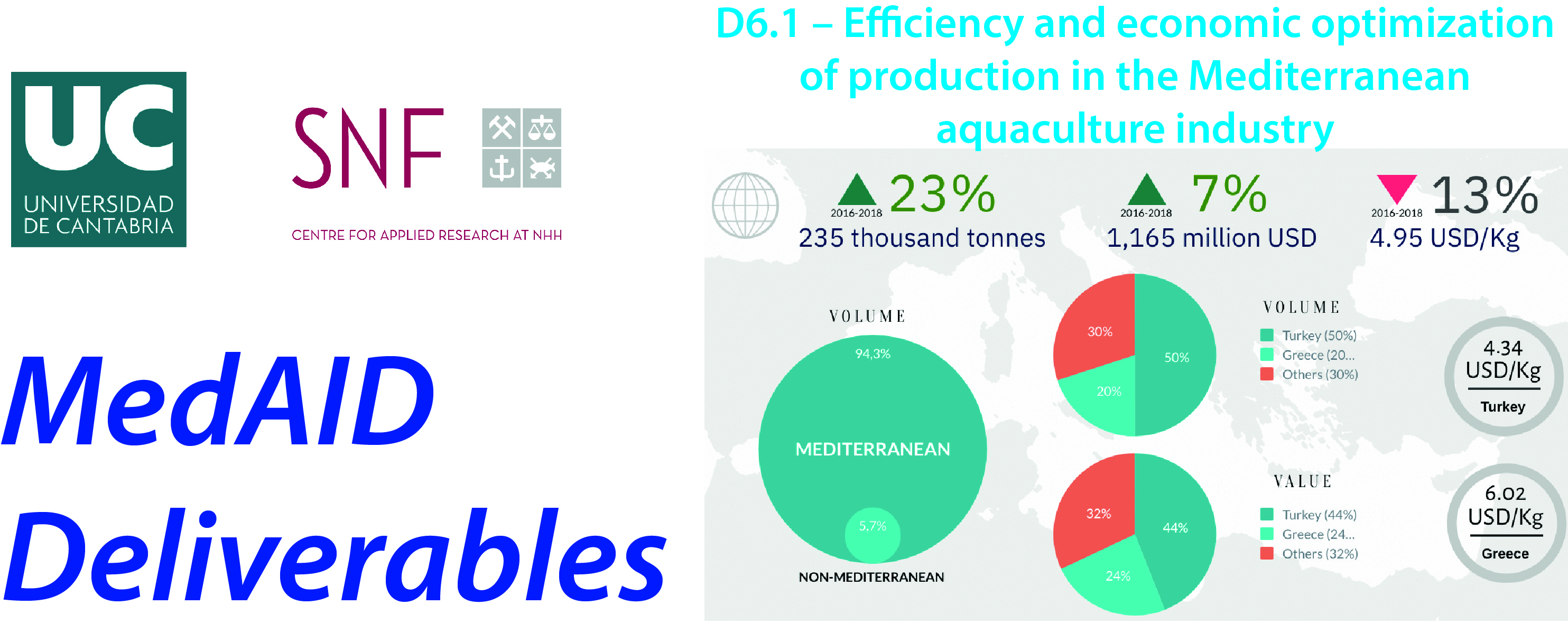The goal of MedAID is to increase the overall competitiveness and sustainability of the Mediterranean marine fish-farming sector, throughout the whole value chain. Despite the positive general trend in the growth of the seabass and seabream industry, in recent years production has experienced problems of economic performance that affect companies competitiveness. In this context, the MedAID Project and, within Work-package 6 (Improving bussiness performance and development of strategic marketing plans), Task 6.1 “Economics of aquaculture production” focuses on analyzing the production efficiency, productivity and optimal production in the Mediterranean aquaculture at company level focusing on seabass and seabream production.
Subtask 6.1.1 has developed a first study whose objective has been to investigate the technical efficiency and scale effects in Mediterranean sea cage farms producing seabass and seabream. Furthermore, environmental effects originating from the farms are also discussed. The study is based on data collected within the MedAID WP1. The technical efficiency effects are analysed using Data Envelopment Analysis (DEA) and a Tobit regression is applied for a second stage analysis of the environmental variables. Results show that the mean technical efficiency is 0.84 and bias corrected mean technical efficiency 0.71. The interpretation is that the average farm could reduce inputs by 16% without reducing outputs, if the average farm was producing in the manner of the best-practice farms in the sample. Scale efficiency is rather low, suggestion that there is room for improving efficiency if firms are operating at a more optimal scale. For the environmental variables reported, feed conversion rate is in line with other papers, but the emission of nitrogen and phosphorus is higher than in other finfish aquaculture industries in EU. This might be due to different regulations on emissions between countries and different feeding strategies among different producers.
A second study has analyzed farm productivity development over time using stochastic frontier analysis (SFA). Data used within these analyses are obtained from the Orbis database, comprising data for the period 2008 to 2016, in an unbalanced data set. Results show that seabass and seabream enterprises have reduced their inefficiency from 2008 to 2016. Although results on enterprises size are not significant, several studies on the seabream and seabass industry suggest that there are economies of scale, and studies on the sea cage farming sector in Norway also suggest that economies of scale exist and that production by each firm has been increasing over time improving technical efficiency and productivity.
To stay competitive is important to consistently focus on improving enterprise performance and reducing inefficiency. This is especially true for sectors with high competition and limited possibilities to differentiate the product. Thus, the seabream and seabass sector seems to be on the right track, however, the current increasing supply puts a downward pressure on prices, which means that a constant improvement is necessary to be profitable. Based on the results of these two analyses it seems that there is room for improving technical efficiency between 10%-30%. This indicates that the seabass and seabream farms can become more productive either increasing their production without increasing their input use or reducing the input used and produce the same amount of fish as they do now. A positive side effect of becoming more technically efficient is that the environmental impact per kilo fish produced will be lower, supporting a more sustainable production praxis.
A way forward to improve technical efficiency, productivity and profitability could be the clustering of enterprises or a more vertical and horizontal integration in the sector. Studies of agglomeration points toward that close interaction in clusters, within the aquaculture sea cage farming sector, has benefits for the industry all along the supply chain. Farms or enterprises located close to each other can benefit from using the same logistics, sharing labor, and exchanging research and innovation. Furthermore, an increased concentration of aquaculture industries can attract input providers, which seems essential for the development of specialized inputs (technology, feed, vaccines etc.) for the industry, and as much as two thirds of the productivity growth may come from supporting industries. It is also indicated that industry clusters are served by more efficient supply chains, which results in higher export prices. Thus, innovation in the whole value chain is of great importance to make the product more competitive. Moreover, industry clusters may also have a higher bargaining power in relation to how the industry is regulated and a higher competition for the use of space in the coastal zone.
It is evident that production and feed technologies are key factors to improve production efficiency. However, the organization and management of production processes are just as important. One of the reactions of seabream and seabass firms to the problems of decreasing competitiveness and profitability in recent years has been a process of business concentration. The increase in the size of the companies implies a greater complexity in the management of the production processes. To this should be added the need to consider an increasing number of variables and factors when making strategic and operational decisions, not only biological or technical, but also environmental, economic, social, political and market ones. In a context in which competition in the markets is greater, managers must take increasingly complex decisions, and in the most efficient way. In recent years, advances in processing techniques and the explotation of large volumes of data through optimization and simulation, have created an opportunity for the development of methodologies supporting decision making in aquaculture.
In Subtask 6.1.2, the decision making process in seabream and seabass production is improved through the application of innovative optimization techniques. Firstly, the simulation of the cultivation processes has been carried out through the use of bioeconomic models and multi-criteria decision making methodologies. This basically means going one step beyond the current expert systems due to the integration of all key decision criteria in a single objective function, allowing producers to consider in their production strategies, their own preferences not only about the economic dimension, but also about other aspects such as product quality or environmental sustainability.

Then, an optimization methodology has been developed, addressing the seabream and seabass production optimization for the first time , in a farm with multiple batches according to those multiple objectives and multiple decisions. Part of the results can be read in detail in Luna et al. (2019a) and Luna et al. (2019b). The results provide a significant leap in knowledge about artificial intelligence methodologies applied to aquaculture production management and, in particular, seabream and seabass cultivation.
Task 6.1.2 also addresses one of the critical points in the generation of knowledge, the transfer and exploitation of the research results. The work in this task has provided a tool, AquiAID (Artificial Intelligence Decisions in Aquaculture), available online in which the stakeholders of the sector can make use of these advances, through a simple interface. This Decision Support System allows simulating and optimizing the seeding and harvesting strategy of multiple batches of seabream and seabass in sea cage farming in a given time horizon. The tool allows considering different preferences on economic, environmental and product quality factors. Furthermore, the tool is capable of determining the optimal strategy by choosing between different feeds. Once the user profile has been created, users can either make use of a basic data set, or they can modify and enter values in aspects as diverse as feed, water temperature or sales prices.
The results have shown the capacity of this tool to determine the cultivation strategies that maximize the results of the preferred decision criteria, without leaving the other aside. The development of a web tool enables whoever is interested in to test the methodology developed in his particular case. Information on how to access and use the tool is available in Annex 1. “ AquiAID Decision support tool user guide” in Deliverable 6.1
Furthermore, the task has begun to work on the theoretical development of several of them, for example, the determination of a sequence of feeds throughout the fattening period, the management of uncertainty regarding climate change and market price, or the optimization of multi-cage production.
Finally, the production and market data for seabream and seabass show a new context of increasing production and lower market prices that reduce firms margins. In this situation, increasing technical efficiency is key to reduce the operational costs and maintain firms profitability. Our results show that seabream and seabass companies have room to improve their technical efficiency, and point to certain key aspects, such as the collaboration between companies, and the development of the entire value chain, including technology, feed and service suppliers. In addition, the development of simulation and optimization models provides new tools to support managers in decision making, and encourages the dissemination of this knowledge through an open web based tool.
Access to the full deliverable

